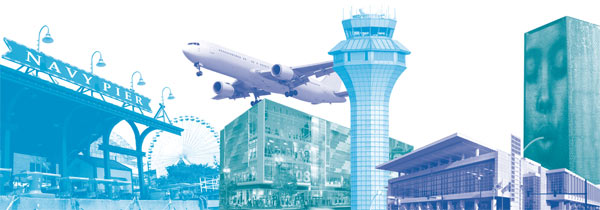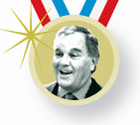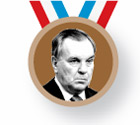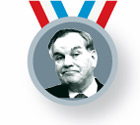
Like his father before him, Mayor Richard M. Daley has pursued a number of big projects during his 20-year reign. His bid for the 2016 Olympics would have been the biggest of them all, had the International Olympic Committee not eliminated Chicago in the first round of voting on October 2nd, awarding the games to Rio de Janeiro.
Here’s a look at some of the mayor’s larger projects. In the spirit of the Olympics, we awarded the mayor a gold, silver, or bronze medal, based on the process and results. We did not include his public-policy– driven efforts; for example, his takeover of the city’s public school and public housing systems. And we also did not include the three professional stadium projects.
 |
NAVY PIER
The plan: Soon after Daley is first elected in 1989, he strikes a deal with Governor James Thompson to re-develop the former World War II pilot training center and U. of I. campus. Thompson agrees to put up $150 million in state funds.
The result: After three years of construction, the new pier opens in July 1995 within budget and boasting more than 50 acres of shops, restaurants, and entertainment, plus a 15-story Ferris wheel modeled after the one invented for the 1893 World’s Fair. Cheesiness aside, Navy Pier is now the number-one tourist attraction in Illinois.
 |
BLOCK 37
The plan: In 1989, the city levels a block between State Street and Daley Plaza to make room for a retail mall with two office towers. The $500-million project, scheduled to open in 1992, is intended to revitalize the Loop, generating an estimated $9 million in annual sales tax and creating 10,500 jobs.
The result: The site sits vacant for 16 years as a succession of deals fizzle. The city finally breaks ground in 2005. In 2008, because of cost overruns, plans to build an underground CTA station with express service to O’Hare and Midway are scrapped—after $213 million has been spent. The retail complex is scheduled to open in November 2009 and be completed in the spring of 2010, but a group of lenders has filed a foreclosure lawsuit against the retail and transit portion of the project.
 |
LAKE CALUMET AIRPORT
The plan: In 1990, Daley announces plans to build a new international airport on the Southeast Side to bolster the area and take pressure off O’Hare. Daley says the new airport, estimated to cost $4.9 billion, will create 235,000 jobs and pump $15 billion a year into the local economy.
The result: In July 1992, Daley pulls the plug on the now $10.8-billion project after the Illinois Senate narrowly rejects a bill to create a new regional airport authority. Daley blames Republican senators for killing the project and accuses Governor Jim Edgar of not working hard enough to rally his fellow Republicans.
 |
REROUTING LAKE SHORE DRIVE
The plan: In 1991, state lawmakers approve $60 million to reroute Lake Shore Drive as part of the $987-million McCormick Place expansion. The plan would move the northbound lanes of the Drive west of the Field Museum, creating a unified Museum Campus where visitors could walk to the Field, the Shedd Aquarium, and the Adler Planetarium without crossing heavy traffic on Lake Shore Drive.
The result: Museum Campus opens in June 1998 to rave reviews and a proclamation from Daley that the architect Daniel Burnham “is smiling down on us.” The final price tag: $110 million, paid for by creating tax districts in the area.
 |
MCCORMICK PLACE SOUTH
The plan: In 1991, the Illinois legislature approves $987 million in funding to double the size of McCormick Place to maintain its ranking as the largest conference center in the United States, a dominance threatened by new conference projects in Las Vegas, Los Angeles, and New York City.
The result: The new South hall opens in December 1996 on schedule and within budget, paid for by tourism-related surcharges on things like hotel rooms and auto rentals. At 2.6-million square feet, McCormick Place is still the largest conference center in the nation.
 |
O’HARE EXPANSION
The plan: In 1999, Daley proposes a $1-billion expansion to build two new terminals and 20 gates. Under pressure to reduce delays, Daley announces an additional $6-billion in 2001 to add new runways and extend others to increase flight capacity at O’Hare by 60 percent.
The result: The project’s costs balloon to an estimated $15 billion as the city plans for more runways, a new western terminal, two additional control towers, and a people mover to link the new and main terminals. The project’s first phase is completed in November 2008, helping to reduce delays by 50 percent in the first five months of 2009, compared to the same period in 2008. In 2009, the city requests to use $182 million in airline ticket taxes to complete the next phases, but the airlines balk at spending more money on the project—now scheduled to be completed in 2012.
 |
MILLENNIUM PARK
The plan: In 1998, Daley announces a $150-million project, scheduled to open in 2000, to beautify a stretch of Michigan Avenue along Grant Park near the Metra and South Shore railroad tracks.
The result: Millennium Park opens four years behind schedule at a cost of $475 million—more than triple the original budget. Yet, with its Gehry-designed bandshell, “bean” sculpture, and lush gardens, architectural critics and urban planners tout the new park as a “cultural spectacle.” Today it’s the second most popular tourist destination in Chicago after Navy Pier.
Photography: (Daley gold) Chicago Tribune photo by Michael Tercha, (Daley silver and bronze) Chicago Tribune photos by Antonio Perez, (Navy Pier) Kenn W. Kiser, (airplane) Sharply_Done/istockphoto.com, (O’Hare Tower) Carterdayne/istockphoto.com, (McCormick Place) Chicago Tribune photo by Chris Walker, (Millennium Park) Chicago Tribune photo by Nancy Stone
Illustration: (Block 37) © The Mills Corporation


